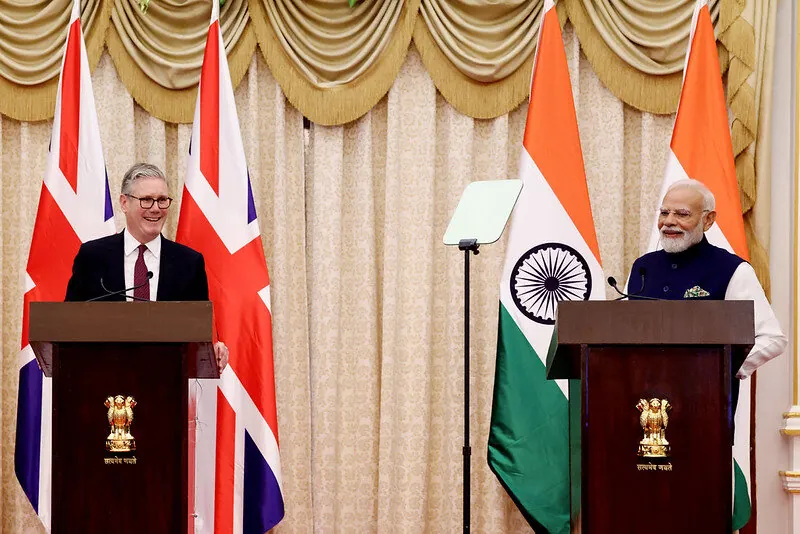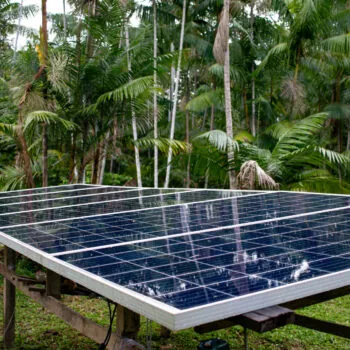UK Prime Minister Keir Starmer’s first official visit to India in October 2025 marked a defining moment in the evolving India–UK partnership. Following Prime Minister Narendra Modi’s visit to London in June—where the two nations signed the long-awaited Comprehensive Economic and Trade Agreement (CETA)—this visit reinforces their shared resolve to build a modern, mutually beneficial, and future-focused relationship under the framework of India–UK Vision 2035.
Amid global trade tensions and shifting geopolitical alignments, the Indo-UK partnership can be especially strategic. Clean technology cooperation — anchored in institutional mechanisms such as CETA — is the need of the hour, and can transform the India–UK partnership from collaboration to genuine co-creation. By aligning climate ambition with trade liberalisation, technology collaborations, and financial mobilisation, both nations can embed sustainability at the core of their bilateral relationship.
Trade and economic cooperation: building pathways for sustainable growth
The Comprehensive Economic and Trade Agreement (CETA) will serve as the overarching framework guiding the next phase of India–UK cooperation—linking trade liberalisation with sustainable growth, innovation, and climate-aligned investment. Following the October visit, both Prime Ministers reaffirmed CETA as the cornerstone of the bilateral economic relationship in a joint statement, unlocking opportunities across clean energy, advanced manufacturing, financial services, and technology. The two leaders also reaffirmed their commitment to achieving net-zero goals—recognising that clean growth represents both an environmental imperative and an economic opportunity.
To operationalise this vision, two key enabling mechanisms were reset: the Joint Economic and Trade Committee (JETCO), to provide structured oversight; and the UK–India Infrastructure Financing Bridge (UKIIFB), a collaboration between NITI Aayog and the City of London Corporation, to mobilise private and institutional capital for sustainable infrastructure.
A key outcome of the visit was also the launch of the India–UK Climate Finance Initiative, designed to scale up green finance and unlock new pathways for low-carbon technologies. Complementing this, both sides announced a joint Climate Tech Start-up Fund, under an MoU between the UK Government and the State Bank of India, to support innovation in climate technology and AI.
The UK–India Clean Energy Partnership: key areas of opportunity
India’s rising economic weight and the UK’s strategic focus on the Indo-Pacific provide a strong foundation for expanding cooperation across trade, technology, and clean energy. For India, priorities increasingly centre on sustaining high economic growth through industrial modernisation and job creation, advancing strategic autonomy amid an increasingly multipolar geopolitical world order, and accelerating its clean energy and digital transitions. The UK has an opportunity to position itself as a key partner in these priority areas while jointly reinforcing leadership in global governance, within the G20, and future COP negotiations.
Building on the impetus provided by strengthened trade and bilateral ties, both nations can now expand and deepen collaboration in several strategic areas:
CETA embeds sustainability into trade and investment flows. This can help provide a strong foundation for exploring and scaling collaborations on clean energy technologies and green manufacturing. India’s rapid renewable capacity expansion and the UK’s technological edge in offshore wind and energy storage create strong complementarities.
Under CETA, both sides can streamline technology collaborations and transfers, increase trade and the ease of investments in renewables and green manufacturing, and promote joint R&D to fast-track the deployment of next-generation advanced renewable technologies, such as solar cells, storage technologies, and grid innovations. This will also require institutionalising clean energy collaboration through regulatory alignment, investment mobilisation, and technology partnerships.
India’s early wind infrastructure now requires repowering. Leveraging the UK’s leadership in offshore and high-efficiency wind technology through the Offshore Wind Taskforce, both countries can explore how legacy wind assets can be modernised and manufacture high-performance turbines in India. Free Trade Agreement (FTA)-linked mechanisms can support standards harmonisation and green investment facilitation, expanding capacity to meet and even exceed India’s 450 GW renewable target by 2030.
A reliable grid underpins India’s energy transition. The UK’s experience in smart grids and digital optimisation can complement India’s domestic efforts. Building on initiatives like OSOWOG (One Sun One World One Grid) and the Green Grids Initiative (GGI), both sides could establish a High-Power Technology Committee to attract investment in high-voltage transmission, grid digitalisation, and AI-driven management systems.
London’s financial ecosystem remains key to scaling sustainable finance globally. Through the UKIIFB and CETA’s green finance chapter, both governments can expand access to concessional and blended finance, sovereign guarantees, and long-term Public-Private Partnership (PPP)-based models—bridging the annual green investment gap and de-risking private capital flows.
Both countries should also actively explore the potential for deepening collaboration and engagements including through diplomatic alliances. For example, the Global Clean Power Alliance (as highlighted in the joint statement) particularly in its finance and supply chain resilience missions, the Energy Transition Council, and multilateral institutions such as the International Solar Alliance and Coalition for Disaster Resilient Infrastructure.
Renewed focus on engagements through such platforms can be mutually beneficially for advancing inclusive clean energy transitions domestically and shape global discourse and solutions on energy, climate and finance. In addition, the UK and India could explore trilateral or plurilateral collaboration on resilient grids for accelerating renewables growth, particularly in emerging economies.
The way forward
The upcoming COP30 in Belém presents an important opportunity to spotlight domestic progress on clean energy transitions, and present a vision of how deepening UK and India partnership can support both in-country ambitions and advance clean energy transitions globally through solutions on finance, technology, and building resilient supply chains.
This integrated approach not only strengthens India’s 2047 development vision but also reinforces joint leadership in the global climate transition — laying the foundation for a resilient, decarbonised, and inclusive future.


